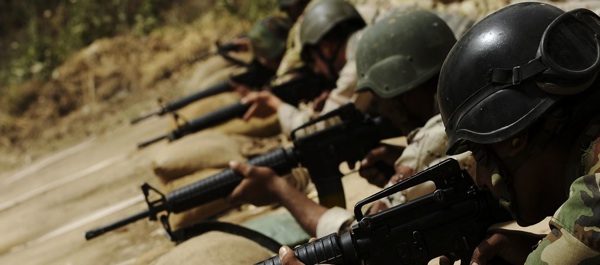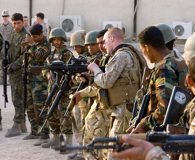Iraq’s New Armed Forces – Special Report

SPECIAL REPORT FROM IRAQ
Lieutenant Colonel Brad Gericke, whose current assignment in the Commander’s Initiative Group, Multi-National Force–Iraq in Baghdad provides him with a unique perspective, shares his observations and insight regarding the Coalition’s efforts to develop Iraq’s national security structure. Armchair General is pleased to present this exclusive Special Report from Iraq.
Iraq’s New Armed Forces:
Emerging as the Middle East’s Best Fighting Force
While maintaining the security gains made over the last year in Iraq, the more than 130,000 U. S.–led Coalition forces there are increasingly working to develop Iraq’s armed forces. Describing their mission as “enabling from overwatch,” the troopers of Multi-National Forces Iraq are advising and training their Iraqi counterparts to create a formidable national security structure that will be capable of maintaining internal security and defending Iraqi territory, airspace, and waters from external threat. By employing American doctrine and training techniques, Iraq’s forces are growing in competence and will soon become a formidable force in a region in which militaries have not performed well – the Israel Defense Force excepted. Iraq’s security forces already number more than 600,000 troops, and with 2008 oil exports in excess of 600 million barrels of oil, Iraq has the money to invest in its military, which it is doing. Iraq has committed to more than $11 billion in arms purchases from the U. S. alone.
 While the Coalition still secures Iraq’s coastline and two oil platforms in the North Arabian Gulf, the Iraqi Navy is gearing up to assume these responsibilities. Headquartered at Umm Qasr Naval base, the small force of 1,800 sailors and marines are organized into a patrol boat squadron and an assault boat squadron. Currently operating several Chinese-made patrol boats, two dozen rigid hull inflatable fast assault boats, and ten launches in various states of readiness, the Navy is expected to acquire new patrol ships and offshore command and support vessels from international makers in the near future.
While the Coalition still secures Iraq’s coastline and two oil platforms in the North Arabian Gulf, the Iraqi Navy is gearing up to assume these responsibilities. Headquartered at Umm Qasr Naval base, the small force of 1,800 sailors and marines are organized into a patrol boat squadron and an assault boat squadron. Currently operating several Chinese-made patrol boats, two dozen rigid hull inflatable fast assault boats, and ten launches in various states of readiness, the Navy is expected to acquire new patrol ships and offshore command and support vessels from international makers in the near future.
The Iraqi Army’s missions include both conventional and counterinsurgency operations. As of early 2009, the army’s combat units consists of 14 divisions, 52 brigades, and 172 battalions totaling about 200,000 personnel, while another 70,000 soldiers man support units, headquarters staffs, and training units. Several more divisions are being fielded this year, although their final composition is not yet decided. Thirteen of the fourteen current divisions are light infantry consisting of 3 or 4 infantry brigades each, with each brigade comprised of three or four infantry battalions. Every division also includes a bomb disposal company; intelligence, surveillance, and reconnaissance company; engineer company; signals company; and motorized transportation regiment.
The Army’s mechanized division boasts more than 150 tanks and nearly as many infantry fighting vehicles. Although the tanks are currently mostly outdated T-72s and T-55s of Soviet design, Iraq is purchasing a brigade complement of the world’s best tank, the U. S. M1A1 Abrams, to equip armor formations still being generated. Iraq’s army is an increasingly professional force that models many U. S. Army practices. For example, Iraqi army trainees learn the Iraqi Soldier’s Creed modeled on the U. S. version, are learning deliberate planning processes, and are instituting a system of schools to educate officers and NCOs.
The Iraqi Air Force, once formidable but a wreck ever since the Persian Gulf War of 1990–91, is still limited to performing basic reconnaissance, mobility and training missions. Its six squadrons are yet modestly equipped with three C-130E transports, a mixture of about twenty single and twin-engine fixed-wing aircraft, and more than thirty helicopters. Upgrades are on the way, however, as orders have been placed for 22 Mi-17/HIP helicopters, several dozen Bell 407 armed reconnaissance helicopters, six C-130J aircraft, and two dozen AT6-B light attack planes. Iraqi air leaders have even expressed interest in the F16 fighter, but employment of this high performance jet would take several years of maintenance, training, and support preparation.
Reflecting Iraq’s history of coups and the still-fragile security at home, a large domestic security apparatus has been created. The forces of the Ministry of the Interior, although not yet fully trained, actually outnumber Defense forces 380,000 to 220,000.
However, political fractures within Iraq are still real, as evidenced by the presence of one other armed force in the country, the Peshmerga of the Kurdistan Regional Government. These troops operate in the Kurdish-controlled north, and are mostly veterans of battles with former dictator Saddam’s troops. They number about 25,000 and lack heavy equipment, but they are a potent force whose relationship with the Iraqi Army is often tense. Leaders on all sides have so far agreed to pursue political solutions to their problems, and if this continues, expect the growing Iraqi military to set a new benchmark for professionalism and capability in the Middle East.
Submitted from Baghdad by Lt. Col. Bradley T. Gericke, PhD.


This is an excellent article, Dr. Gericke!
Have you come across high-quality, battle-hardened Iraqi veterans–with combat experience against the Iranians and/or even 1990/2003 Coalition forces? Do these veterans make good officer material? They must have interesting stories to tell!
Or does the Coalition prefer younger clean-slate Iraqis to mold more easily?
Thanks again, and all the best,
Laurent Aerts
Vancouver, BC, Canada